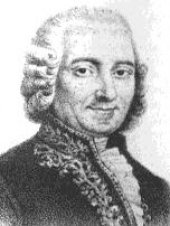Born in 1743 at Lucca, he passed his infancy in daily contact with music. From an early age the children of Leopoldo, singer, violocellist and double bass player in the Palatine Court of the city began to study counterpoint and an instrument, in Luigi’s case, the violoncello. After his first schooling both at home and at the Archbishopric seminary under the guidance of Father Vannucci, he perfected his studies at Rome with Tartini’s pupil, Giovanni Battista Costanzi who was the kappelmeister of the Julian Chapel at St. Peter’s. Boccherini made his debut in 1756 when he was registered as a participant in the festival of the Holy Cross at Lucca as a musician. Soon after, at only fifteen years of age he moved to Vienna where he was employed together with his father in the orchestra of the Imperial Theatre. He left Vienna the following year hoping to gain a stable post in the town of his birth but he was unsuccessful in receiving any offer from the local authorities despite performances both in an orchestral and in a soloist capacity. Between 1760 and 1764 because of the precariousness of his professional position, he returned to the Austrian capital where the liveliness of the musical scene (these were the years in which Gluck was productive) could guarantee him the possibility of being recognized, both as a virtuoso and as a composer. Already in these first works datable to his younger period – such as the first collection of trios for strings and the six quartets op. 2 – certain “Boccherinian” characteristics are very evident; for example, the solo balance between the instruments (having freed the viola and violoncello from the more common basso continuo role in which they were heretofore used); and an even distribution of the melody between the parts; a use of themes sometimes “galante”, sometimes impetuous whose use gives a precise consequence to the formal structure. The Viennese experience finally ended in April 1764 when the Council of Lucca offered Luigi a post in the Palatine Chapel for which he composed two oratorios, “Gioas, re di Giuda” and Giuseppe liberato” as well as many other sacred vocal pieces to be performed on the occasion of the city festivals. In the same period an enormously important meeting took place in Milan between Boccherini and Giovanni Battista Sammartini and the formation of a string quartet with Filippo Manfredi and Pietro Nardini, violins and Giuseppe Maria Cambini, viola. The quartet was active for six months and their repertoire included works by Haydn and Boccherini. After the death of his father in 1766 he left the city of his birth for ever and together with Manfredi stayed in various northern cities before establishing himself in Paris for a year. Here, he was introduced into the Marquis De Bagge’s salon where he had the opportunity of meeting the most important French musicians of the day and where he was able to establish relationships with the two editors Vénier and La Chevardière with whom he published many works. He then moved to Madrid and in 1770 entered into the service of Don Luis Infante di Spagna, a person deeply enamoured of music and who already maintained a quartet formed by the Font family. This employment gave him the possibility of frequenting the more refined sections of the Madrid society and also of learning the characteristics of traditional Spanish music which influence is evident in the later compositions of the Luccan composer. Infante, who was capable of understanding and appreciating his protégé was amply repaid by a vast and mature output which he could enjoy thanks to the talented players in his employ, not the least of which being Boccherini himself. Quintets made up the greater portion of his compositions in this period – a total of 30 divided up into 5 collections – which compositions acquired a series of characteristics particular to this genre; an extension of the dialogue type of structure already existing in his quartets, an enrichment of the sonority which leads to a more efficient use of the play between thin and full instrumentation and the elevation of the violoncello to the status of a full solo part having an active role in the development of the musical themes. He also wrote several lengthy symphonies for a full range of orchestral instruments but when the Infante left the court he returned to the composition of chamber music and adopted the “small” form in two movements and also the “intimate” form. This latter was certainly more suitable for Don Luis’ more recent situation and had the added benefit of being much sought after in Europe which was modeled on the requests formed by aristocratic amateurs. When the Infante died in 1785 Luigi found himself in great economic difficulty which he tried to get round by appealing to wealthy sponsors in the court of Frederick William of Prussia to whom he furnished quartets and quintets for which he received the sum of 1,000 scudi per annum. He also found employment as the conductor of Count Benavente-Osuna’s private orchestra for which he composed numerous symphonies. Benavente-Osuna’s theatre saw the production of his only dramatic composition, the zarzuela “Clementina” which was staged in 1786. The count also commissioned him to transcribe twelve quintets originally written for string quartet plus violoncello for guitar and strings. In the same period he also transcribed a concerto using the guitar as the solo instrument. By these two modifications of pre-existing works he gave the guitar its present role in an orchestral context both as a solo instrument and as a “doubling” part. His last years were spent in poverty, as the Madrid society which had previously shown him such favour and support now withdrew its interest. He died in 1805 and was buried in the church of S. Juan but in 1927 the body was exhumed and taken to Lucca where it was entombed in the church of S. Farncesco. From the years 1760 on, Boccherini started to catalogue his vast output thematically, an undertaking that was to remain incomplete since he failed to include vocal works, some orchestral pieces and the cello sonatas. From an analysis of those works omitted it would seem that the author only intended listing those works which were to be published. The catalogue appeared in two printed editions in the second half of the nineteenth century. The autographed edition was destroyed during the Spanish Civil War.
Vocal Music
Aria Accademica in re min. n. 5
Instrumental music
Sinfonia in Si bem. Magg. op. 21 n. 5 (G 497)










